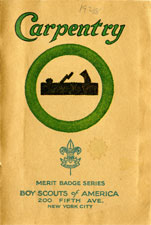This Historic Merit Badge could be earned only during calendar year 2010,
in honor of the 100th anniversary of the Boy Scouts of America.
It was first offered in 1911 and discontinued in 1952.
THE BADGE IS NO LONGER AVAILABLE
BSA allowed additional time until March 31, 2011, for those
at the local council who enter advancement based on forms
submitted,
or unit management software file uploads provided. It also applied to unit
advancement processors using Internet Advancement.
This was not intended as an extension of time to earn the badges;
only as additional time for data entry
. Troops could submit advancement reports for Historic Merit
Badges earned by Scouts before December 31, 2010 through March 31, 2011.
BSA had a special program in honor of the 100th anniversary of the founding of the BSA, which included the reintroduction, for 2010 only, of four Historical Merit Badges - Carpentry, Pathfinding, Signaling, and Tracking.
The basics of the 2010 Historical Merit Badge program included:
- An overall goal of the program was for a majority of the BSA’s registered Boy Scouts to earn one or more of the merit badges during the centennial year, 2010.
- The badges offered had a history that can be traced back to the origins of the BSA.
- The original requirements were used, as well as supported by scanned pages of the early merit badge pamphlets so a Scout could view what a Scout 100 years ago used. Supporting the scanned pages of the original pamphlets were information guides for each merit badge that explained what a Scout of 1910 might have experienced, along with background information to assist a Scout in understanding what may be unfamiliar terms.
- The contemporary merit badges closely resemble the original designs of their counterparts with the exception of the border, which is gold. The unique border will immediately identify them as 2010 historic merit badges.
- The four historical merit badges could be used toward a Scout’s rank advancement if they were earned by December 31, 2010.
- The effective date for earning these new merit badges was April 1, 2010, and requirements had to be completed no later than Dec. 31, 2010..
- The BSA did not reprint the pamphlets for these merit badges. Reprints of the original merit badge pamphlets were posted to http://www.scouting.org/BoyScouts/AdvancementandAwards/MeritBadges.aspx
Download a pdf of the Original Merit Badge Book
Download a pdf with the New Information for This Merit Badge
These are the original requirements written in 1911.
Requirements:
To obtain a Merit Badge for Carpentry, a Scout must:
- Demonstrate the use of the rule, square, level, plumb-line, miter, chalk-line and bevel.
- Demonstrate the proper way to drive, set, and clinch a nail, draw a spike with a claw-hammer, and to join two pieces of wood with screws.
- Show correct use of the cross-cut saw and of the rip-saw.
- Show how to plane the edge, end and the broad surface of a board.
- Demonstrate how to lay shingles.
- Make a simple article of furniture for practical use in the home or on the home grounds, finished in a workmanlike manner, all work to be done without assistance.
BSA Advancement ID#:
139
Requirements last updated in:
2010
Pamphlet Publication Number:
00000
Pamphlet Stock (SKU) Number:
NONE
Pamphlet Revision Date:
1928
| Worksheets for use in working on these requirements: | Format | |
|---|---|---|
| Word Format | PDF Format | |
Page updated on: May 08, 2022









